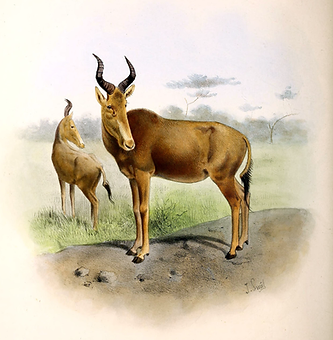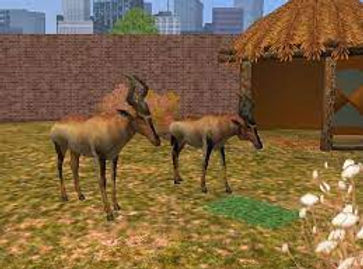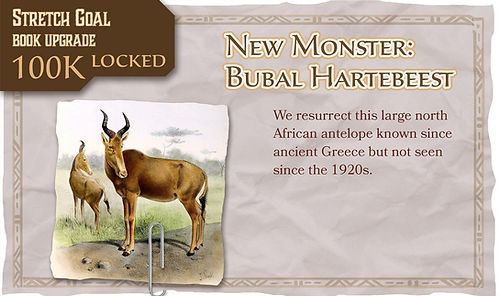Creature
Fast Facts
Introducing you to extinct species.

THE
BUBAL HARTEBEEST
1. The bubal hartebeest, Alcelaphus buselaphus buselaphus, was the only of 8 subspecies of hartebeest to live north of the Sahara Desert and is the only extinct subspecies. 2. Its Latin name ‘bubalus’ and the Greek word, ‘boubalos’, were the origin of the term ‘buffalo’ today. 3. The bubal hartebeest stood 43 inches at the shoulder, had U-shaped horns, and was sandy brown with black at the tip of its tail. This subspecies' distinctive marking was described as, "an ill-defined patch of greyish on each side of the muzzle above the nostrils." 4. This hartebeest was a social animal, traveling in herds of 100 - 300 animals. 5. The ancient Egyptians domesticated the bubal hartebeest and used them in sacrifices. There was even a hieroglyph meaning "baby hartebeest" also existed. 6. It was referenced in the Old Testament in 1 Kings 4:23 as the “Yachmur” and is likely the kosher animal known as the "the'o" in Deuteronomy. 7. The bubal hartebeest was kept in early zoos and private collections. The last captive bubal, a female, died in Paris in 1923. 8. It was protected in 1933 at the London Convention, but it was believed to have gone extinct 8 years earlier, in 1925.
Extinction
Cometh
Facing the light at the end of the tunnel
EXTINCTION DATE
1925
The bubal hartebeest was the first hartebeest subspecies to be named. It ranged throughout the region north of the Sahara Desert from Senegal in the west to Eritrea and Ethiopia in the east and down to central Tanzania. Its northern range was limited by the Mediterranean Sea. It was known by the Greeks and Romans. This hartebeest was mentioned in the Old Testament of the Bible as a ‘kosher” animal. The ancient Egyptians raised bubal hartebeest, used them in sacrificial ceremonies, and even had a hieroglyph for them. Large herds were still roaming Morocco in 1738. As Europeans began colonizing northern African nations, the bubal hartebeest population began to plummet. The French military slaughtered many hartebeests when they conquered Algeria. By 1867, they were limited to the north western mountains of Africa. The last one in Tunisia was killed in 1902. 12 of the last 15 animals were killed by a single hunter in Morocco in 1917. The last captive female died in Paris in 1923. The final bubal hartebeest was killed in Missour, Morocco in 1925. As Europeans began colonizing northern African nations, the bubal hartebeest population began to plummet. The French military slaughtered many hartebeests when they conquered Algeria. Although Jurassic Park is fiction, scientists are working on several de-extinction projects. In fact, in 2003 scientists did bring back the extinct Pyrenean ibex, a type of wild goat, for 7 minutes before it died, showing de-extinction is possible. The bluebuck might be a candidate. Scientists would potentially use DNA from one of the museum specimens to try to bring them back to life. Africa is home to many unique and endangered species. Although many efforts are being made to protect wildlife, poaching continues to be a real threat throughout the continent. Many African governments are launching new initiatives to help citizens to invest in their natural resources and unique wildlife. If the bubal hartebeest was brought back from extinction, would it be able to adapt and survive north of the Sahara Desert today?
COMING SOON
The bubal hartebeest's Lazarus Tale has yet to be written. Would it be able to thrive again in South Africa if it did return?
More to Explore
All answers lead to more questions

Lewis Medland's photograph of a female bulbal hartebeest at the London Zoo in 1895 flipped and colored for comparison.
Image from Alchetron
VIDEOS & ADDITIONAL INFO
Bubal Hartebeest - Quick Facts
Detailed Article about the 8 Hartebeest Subspecies
Video of 10 Extinct Animals - Video (Start at 0:27)
5 Recently Extinct Animals - Video (Start at 7:33)
African Wildlife Foundation - Hartebeest Facts

Egyptian hieroglyph showing a
hartebeest hunt
Image from Reddit



Painting from the
Book of Antelopes 1894
Image from Wikipedia
The known historical range of hartebeest subspecies from The Kingdon Field
Guide to African Mammals 1997
Image from Wikipedia
An engraving from Antoine Jussieu's "Dictionary of Natural Science," Florence, Italy, 1837
Image from Wikipedia

A graphic showing information about the Alcelaphus for their August is for Antelope Series
Image from Peppermint Narwhal

Hartebeest subspecies: bubal hartebeest (centre); (clockwise from top-left corner) red hartebeest, Lelwel hartebeest, Swayne's hartebeest, western hartebeest, Neumann's hartebeest, Lichtenstein's hartebeest, Coke's hartebeest and tora hartebeest, from Great and Small Game of Africa

Hartebeest subspecies from Handbook of the Mammals of the World - Volume 2 Hoofed Mammals 2011
Image from Treatment Bank

The hartebeest from the game
Zoo Tycoon 2
Image from Deviant Art

The Bubal Hartebeest was added to the "Book of Extinction
Image from Mage Hand Press on Facebook



